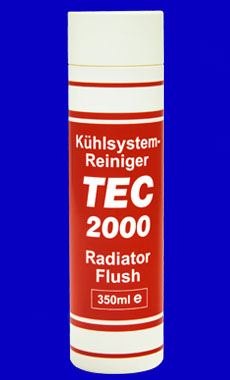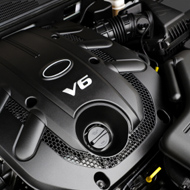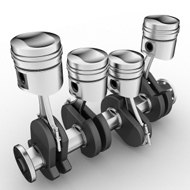
Radiator Flush
Technically the World's Best
What it Does
 Radiator Flush will quickly clean dirty automotive cooling systems and free them of insulating layers of scale and lime deposits. It will also attack rust and in particular, lime-scale deposits are often troublesome in areas where lime content of the local water is high and build up is a problem. It is useful to remove the residue left behind by old antifreeze when it is drained. These deposits in themselves can cause blockage of certain areas in the cooling system, after a number of years of draining and refilling with new antifreeze. While it is cleaning, it will not attack metal or rubber parts of the cooling system and, of course, there is no need to strip the cooling system in order use the product. Because it is so very powerful, there is no need to use expensive complex aids such as flushing machines which are often recommended with other radiator flushes.
Radiator Flush will quickly clean dirty automotive cooling systems and free them of insulating layers of scale and lime deposits. It will also attack rust and in particular, lime-scale deposits are often troublesome in areas where lime content of the local water is high and build up is a problem. It is useful to remove the residue left behind by old antifreeze when it is drained. These deposits in themselves can cause blockage of certain areas in the cooling system, after a number of years of draining and refilling with new antifreeze. While it is cleaning, it will not attack metal or rubber parts of the cooling system and, of course, there is no need to strip the cooling system in order use the product. Because it is so very powerful, there is no need to use expensive complex aids such as flushing machines which are often recommended with other radiator flushes.
What is it
 Radiator Flush is probably the most powerful cooling system flush on the market to day. It is a sophisticated, carefully researched blend of chemicals designed to clean quickly and efficiently but containing special buffering chemicals that protect healthy metal and rubber parts of the cooling system.
Radiator Flush is probably the most powerful cooling system flush on the market to day. It is a sophisticated, carefully researched blend of chemicals designed to clean quickly and efficiently but containing special buffering chemicals that protect healthy metal and rubber parts of the cooling system.
How to use it
One bottle of  Radiator Flush should be added to the average motor car cooling system with the engine idling and at operating temperature. Make sure that the heater is switched "on". Run the engine at idle speed for 20 - 25 minutes. Drain entire cooling system. Refill the cooling system with clean water and drain again in order to remove all the flush. Repeat once more if in doubt. Refill the cooling system adding the correct percentage of antifreeze and for added protection, 1 bottle of
Radiator Flush should be added to the average motor car cooling system with the engine idling and at operating temperature. Make sure that the heater is switched "on". Run the engine at idle speed for 20 - 25 minutes. Drain entire cooling system. Refill the cooling system with clean water and drain again in order to remove all the flush. Repeat once more if in doubt. Refill the cooling system adding the correct percentage of antifreeze and for added protection, 1 bottle of  Anti-freeze Booster.
Anti-freeze Booster.
 Radiator Flush should be used whenever the antifreeze mixture is changed and whenever deposits such as lime, rust or scale deposits are noticed in the cooling system. It should also be applied after a head gasket failure which is very often caused by engines running at above specification temperatures (overheating). Overheating in turn, is usually caused by deposits forming in the cooling system which slow down the rate of heat dissipation and transfer from the engine parts into the cooling water and from the water via the radiator, into the air.
Radiator Flush should be used whenever the antifreeze mixture is changed and whenever deposits such as lime, rust or scale deposits are noticed in the cooling system. It should also be applied after a head gasket failure which is very often caused by engines running at above specification temperatures (overheating). Overheating in turn, is usually caused by deposits forming in the cooling system which slow down the rate of heat dissipation and transfer from the engine parts into the cooling water and from the water via the radiator, into the air.


